Wo Long: Fallen Dynasty Review
Parry On My Wayward Son
When Nioh dropped in 2017, Team Ninja proved that it could marry its top notch action gameplay with meaningful RPG systems. Since then, it has been iterating on that success, pushing at the edges of difficulty and playing around with different kinds of RPG mechanics. Its newest effort is Wo Long: Fallen Dynasty, an action RPG that brings players to the fall of a version of the Han Dynasty that’s also being ravaged by a scourge of demons. Wo Long is another generally good variation on Nioh, being more approachable in the ways it streamlines its character building while more restrictive in the more focused nature of its combat.
In Wo Long, turmoil engulfs China as war erupts over Elixir, a sacred substance that acts as a path to power and immortality. The First Emperor of the Qin tries to claim it, failing in the attempt. Hoping to succeed where the Emperor failed, the fractured factions of China began to war over Elixir. The player wakes up in the midst of a heated battle, having staved off death with the help of a talisman. The use of this talisman alerts a mysterious figure known as the Taoist in Black, who seeks to corrupt the Divine Beasts using Elixir so as to claim their power.
It may sound like a lot of setup, but the story of Wo Long plays out in a very mundane fashion. The player character does most of the work before being largely sidelined into cutscenes to make way for famous figures who are of historical importance, but only serve as exposition delivery vehicles here. The standard fashion that cutscenes play out mean that any story detail and depth quickly washes away, as the cutscenes themselves are also simply not interesting. Many players will wish them to be over quickly so that more interesting parts of the game can be gotten to.
Fortunately, Wo Long is far more about its gameplay. The game is divided into missions, each a fairly linear trek through a war-torn city or fortress with a few naturalistic levels thrown in for good measure. Each mission consists of the player fighting through enemies to get to the end where a boss usually awaits. But Team Ninja has added in some elements that help to make exploring a bit more dynamic. The first is the jump button, which helps to expand the levels upwards. snappiest jump, and the game will sometimes call for minor platforming when the fluidity required isn’t up to the task, but Team Ninja gives a pretty generous reach for the player to pull themselves up ledges. It undeniably makes the levels more dynamic, especially when offering new ways of approach for specific enemies and more stealthy strategies.
The second addition is the Morale system. Morale functions as a general power level for the both the player and enemies in a level, with higher Morale equaling more power. Morale increases as the player deals out damage and decreases as they take damage, dropping to zero on death. On its face, Morale is an artificial difficulty curve for each level, one that exists to promote exploration. Players can find Battle and Marking Flags around the map and raise them to increase the minimum Morale rank for the level. Many flags are hidden off the beaten path but finding them rewards the player with a full heal and an increase to minimum Morale Rank for the level. But they often end up feeling perfunctory. Rather than a fun reward for going off the beaten path, players are much more likely to seek them out to hedge their bets, anticipating a death or two against the boss and not wanting to go grind on the monsters in the level to increase Morale to put them on equal footing. It’s an admirable attempt to spice up the level design and sometimes the sight of a flag brings with it a satisfying gasp of relief. But too often it feels like another thing to collect. Levels aren’t wholly without merit, but the obvious signposting doesn’t give them the chance to feel real or distinct, instead feeling like a series of encounters broken up by some walking segments.
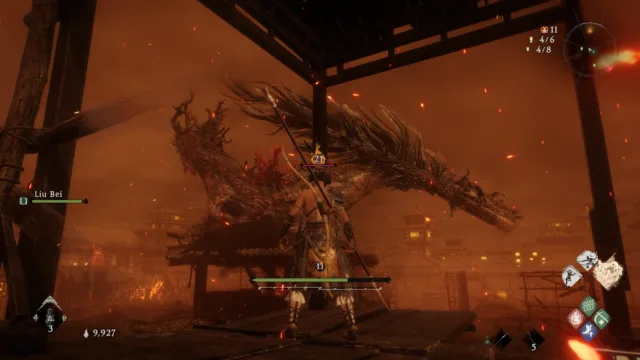
This dragon provides one of the rare shakeups to the structure of a level, pressuring the player to find cover while it calls down lightning.
Wo Long‘s strongest element is its combat. Team Ninja has reorganized the standard stamina meter found in many modern action RPGs and replaced it with the Spirit Gauge. The Spirit Gauge is a measure of the general flow of combat, and like Morale it increases as players attack and decreases as they are attacked, creating a push and pull effect. If a character or enemy’s Spirit Gauge ever reaches its lower limit, that individual is left in a defenseless state and open to a highly-damaging Fatal Blow. A higher Spirit Gauge gives the player more Spirit to spend on special Martial Arts, spells, parries, and blocking, all of which consume Spirit. It’s a truly clever system that encourages aggressive play while limiting more powerful abilities without the need of a stamina or mana bar.
Parrying in particular feels incredibly satisfying and Team Ninja has tuned the mechanic to be very forgiving for the player, easing them into the combat and providing a real sense of power. If there is any knock against the combat to be had, it’s that parrying is given such a prominent focus in combat that everything else plays second fiddle. Enjoyment of the combat will rely heavily on the player’s competency with parrying and combat slows considerably without its utilization. Enemies all have access to unblockable attacks that can still be parried and doing so will reward the player with the most meaningful gains on an enemy’s Spirit Gauge possible. Bosses have several and often will only really open themselves up after several successful parries of these attacks. Ultimately this is a minor quibble in what is otherwise the game’s brightest component.
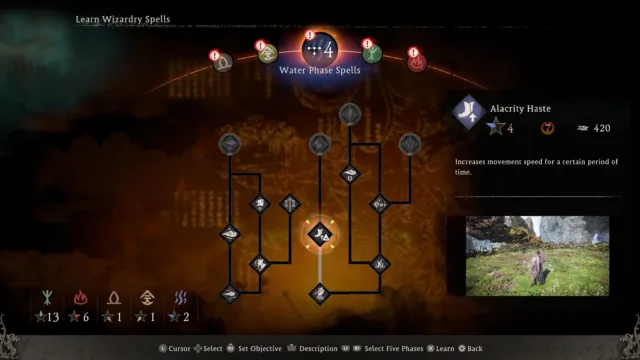
Wo Long’s Spell trees aren’t overly complex and each of them gain an additional point to spend every five levels.
The most streamlined element of Wo Long is its RPG mechanics, which centers around five Virtues: Wood, Fire, Earth, Metal, and Water. Each Virtue governs several stats, has its own spell tree, and influences which weapons the player character is adept with. Though learning spells has a Virtue threshold, actually using them has a Morale threshold, gating their accessibility in a given level until Morale Rank reaches a certain point. Spells are complementary to all builds and their powerful effects round out the character’s arsenal or enable new builds. Likewise for equipped weapons, which each come with at least one Martial Art, a special attack that broadens the effective number of attacks at the character’s disposal.
What doesn’t feel streamlined enough is the game’s loot system. Wo Long features randomized loot, bursting like a piñata from defeated enemies with regular frequency. Ranked by rarity, which determines the number of special properties the weapon or armor has, and level, which determines the general power, much of the time between levels will be spent fiddling with equipment. There is a wide variety of weapons available and the game is kind enough to have available upgrades for each keep pace so if players desire they can pick a weapon and stick with it for most of the game. Otherwise, a series of menus await as equipment is sold for money, salvaged for component parts, or filtered through to actually be considered for use. It’s possible to spend time altering the random abilities of equipment to better suit the character’s build, but making crafting gems out of the vast majority of loot dropped is underwhelming. The upside is that there’s a good amount of player freedom here, especially when considering that players can freely respec their characters.
Perhaps the most disappointing aspect is the shallow sense of depth. There’s a general lack of a power curve present as one progresses. Sure, stats increase, but this just makes the numbers go up. The only new elements that get introduced as the game goes on are new spells and Divine Beasts unlocked by progressing through the game. Divine Beasts are the final component of a player’s build, providing stat increases and passive benefits as well as one of two powerful abilities that can be activated when the Divine Beast Gauge is full. But even here each Divine Beast tends to only fit specific builds and there is little impetus to change them unless the player decides to take the character in a whole new direction or as a direct counter to a enemy’s elemental affinity. As a result, the actual play of the game between the first and final levels is pretty much the same. This makes the game feel repetitive, not helped by the optional side quests just being the game’s existing levels with slightly rearranged enemy placement. Some levels make attempts to change up flow, such as a one midway through the game that has the player running from a dragon’s lightning by rushing from cover to cover, but most of the time will be spent on similar blasted battlefields and corrupted cities.
Wo Long could also stand to be in better shape technically. It has a dated look to it, not helped by the game’s stark brownish-red palette, and the Steam version played for review stuttered infrequently, with a specific cutscene consistently crashing and requiring skipping to proceed. This is also a game where one should consider turning on the Chinese audio, as the English performances are subpar and clash with the game’s dark aesthetic. However, while the game’s music has a tendency to fade into the background, the sound design is quite excellent, providing key aural feedback that helps to clarify the many aspects of fights.
Far from an unqualified win, Wo Long does manage to be an entertaining ride. When it leans into the strength of its combat it’s a joy. But much like that combat, there’s a push and pull to the changes that never quite coalesce. The inclusion of jumping makes the levels more fun to explore but the addition of Morale blunts any surprise the exploration might yield. The level of freedom given to customizing weapons is admirable, but when parrying is always the most powerful option everything else feels flatter as a result. Still, with top notch combat and a good amount of player experimentation there’s a lot of fun to be had. Just don’t expect to be blown away.
Disclosure: This review is based on a free copy of the game provided by the publisher.
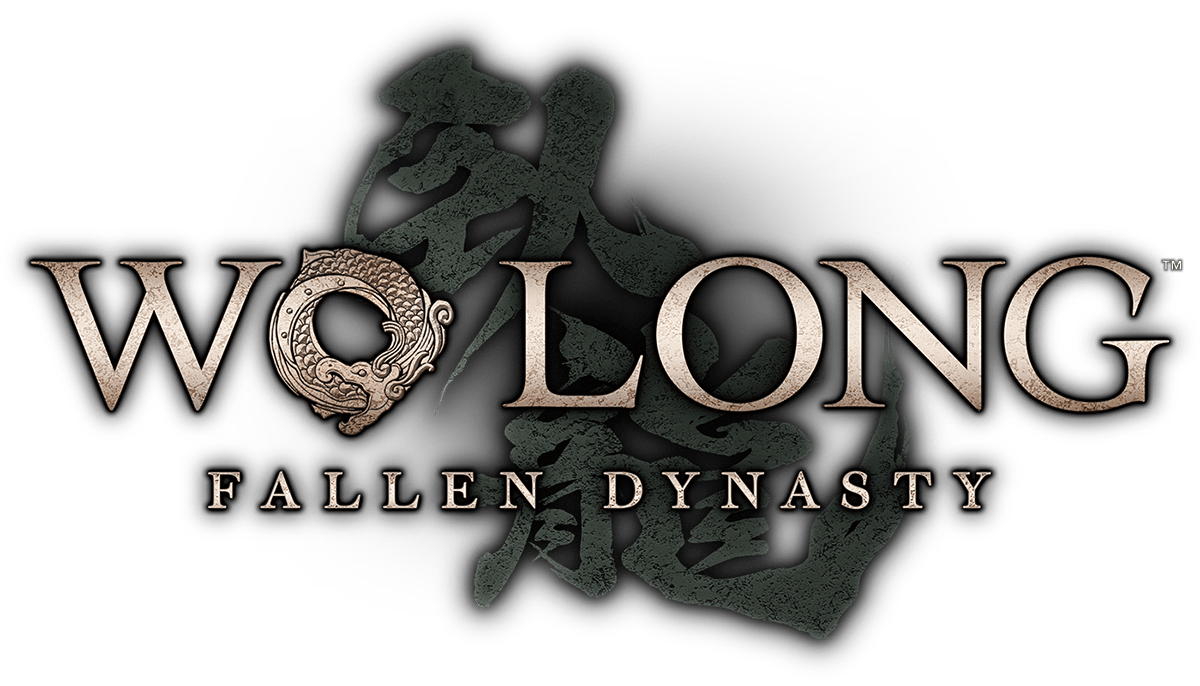

Combat as fluid and fun as ever
Streamlined mechanics cuts down on menu time...
...but not quite enough
Bland story does little to grab attention
Visuals are muddy and performance is uneven
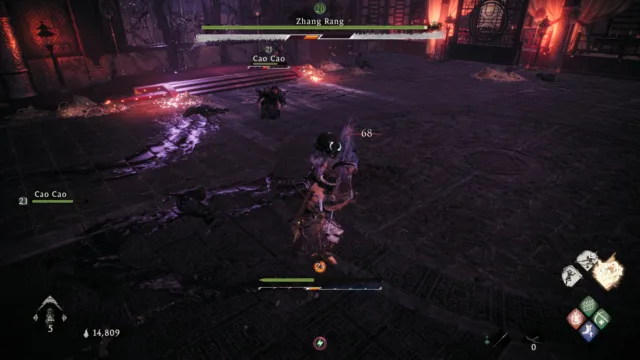
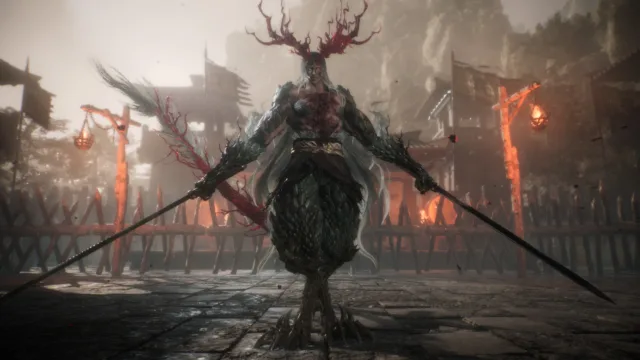






Recent Comments